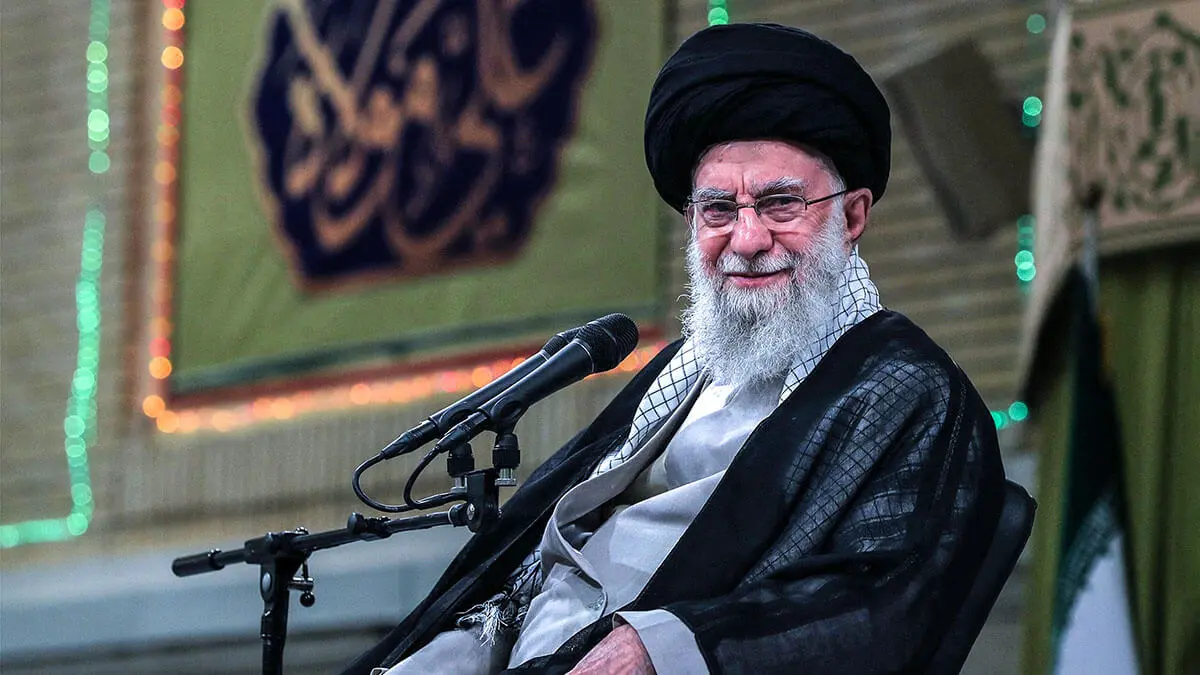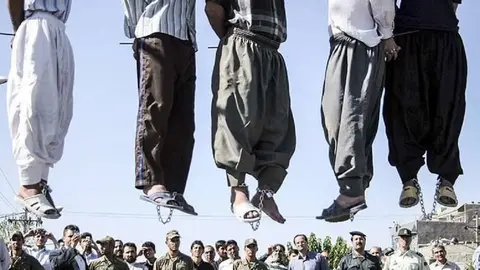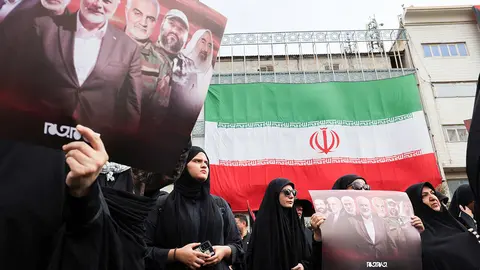Iran: the regime's failures in 2024 and the challenges facing the country

On Sunday 19 May 2024, Ebrahim Raissi, President of the Iranian regime, and Hossein Amir-Abdollahian, Minister of Foreign Affairs, were killed in a helicopter crash in north-west Iran. Although the Iranian President has an executive role and the Supreme Leader, Ali Khamenei, still holds ultimate power, the loss of Raissi was a major blow to the Iranian people.
Faced with intense waves of national uprisings, each dealing a harder blow than the last to the structure of the regime, Ali Khamenei, like other dictators, has found only one solution: to purge his government of any element that is not completely subordinate to him.
However, Khamenei has lost his key pawn. Raissi acted as a central pivot, putting all government institutions at the direct service of Khamenei's inner circle, the Revolutionary Guard Corps (IRGC) and other loyal structures, coordinating them entirely for the benefit of the Supreme Leader.
Legislative and presidential elections
After the death of Raissi, Massoud Pezeshkian was elected President on 5 July. However, Pezeshkian was not Khamenei's choice. The ‘reformers’ had made their participation in the restricted sphere of the regime conditional on the presentation of at least one candidate in the elections. This is how Pezeshkian became president. By his own admission, less than 8% of the population took part in the elections, mainly servicemen, soldiers and people afraid of losing their subsistence allowances.
War in the Middle East
The impact of the 2019 and 2022 uprisings on the regime and the orchestration of the war between Hamas and Israel. In the wake of the 2019 uprisings, and even before, during Rouhani's second term, Khamenei had launched the project of ‘purifying his regime’ to deal with the devastating waves of protests.
- The 2019 uprising: This uprising was put down by Khamenei with a direct order to fire live ammunition, resulting in the deaths of 1,500 young Iranians born in the 1980s.
- The 2022 uprising: This was brutally suppressed with massacres, mutilations (including the blinding of demonstrators) and the systematic use of sexual violence.
These two uprisings shook the foundations of the regime. Like any dictator, Khamenei sought to divert attention and repress Iranian society by orchestrating the war between Hamas and Israel. This war was intended to intimidate and subdue the Iranian people in order to prevent further uprisings and, ultimately, the downfall of the regime. However, the massive boycott of the parliamentary and presidential elections, with only an 8% turnout, once again set alarm bells ringing for Khamenei.
The two pillars of the regime's survival
The Iranian regime's survival strategy has always rested on two fundamental pillars:
- War and the export of terrorism abroad.
- Brutal repression at home.
The regime has pursued its warmongering and terrorist policies abroad through three main levers:
- Proxy forces.
- The development of long-range missiles.
- The quest for nuclear weapons.
War turns against the regime:
Although the Iranian regime fuelled the war in the Middle East by supporting Hamas financially, logistically and militarily, in the hope of using the ensuing crises as a bulwark against uprisings in Iran, this strategy backfired. Despite its determination to stay out of the conflict, this led to the sudden loss of the regime's investments of several years, including its alliances with Hamas and then Hezbollah, which literally evaporated.
The fall of the Syrian dictator
Khamenei had always repeated that ‘if we do not fight in Syria, we will have to fight in Tehran, Isfahan and Shiraz’. This is how he established his ‘line of defence in Syria’. However, Syria was not just a simple corridor for delivering weapons to its proxy forces; it was a receptacle for the regime's warmongering policy, a rear-front for all its proxy forces.
Iran had seven air bases and more than 500 strategic points and bases in Syria. Khamenei had spent hundreds of billions of dollars from the pockets of the Iranian people, and thousands of members of the Revolutionary Guards had been killed. Yet all these investments, along with his proxy forces, were wiped out in an instant. Today, the regime no longer carries any weight in the region. So, in Khamenei's own words, must it now establish its line of defence directly in Tehran?
The defection of the regime's forces
The loss of its strategic depth, the mortal blows dealt to its proxy forces, the many casualties suffered in Syria, as well as the crushing economic and social crises - marked by galloping poverty, unemployment and inflation - have surrounded the regime on all sides. A way out of these crises seems impossible without structural change, leaving the regime on the brink of collapse.
As a result, the forces of the regime are increasingly reluctant to tie their fate to that of this declining system. Voices of protest are being raised even within the circles of power. For example, Soleimani Ardestani, a cleric and member of the Assembly of Teachers in Qom, directly criticised Khamenei, saying: ‘A dictator oppresses his own people, and we intervene to support him, calling him the defender of the holy places! The regime has made an appalling mistake and must apologise to the nation, without trying to embellish it. Why should we defend a bloodthirsty dictator? These arguments, according to which the line of defence had to be moved to protect us, are neither ethical, nor religious, nor legitimate! They are not defensible! What we are hearing has nothing to do with religion!
Khamenei's speeches
Since the fall of the Syrian dictator, Khamenei's speeches have focused mainly on boosting the morale of his forces, particularly within the Revolutionary Guards and the Basij militia. He tirelessly repeats that ‘the young Syrians will take Syria back’ and that ‘the blood shed was to defend the holy places and was not in vain’.
In a speech, he explicitly stated that anyone who undermined people's morale would be punished. This clearly shows that his forces are in disarray and retreating.
The immobilisation of the Qods Force:
The Qods Force, the external branch of the Revolutionary Guards (IRGC), is now also immobilised. The fall of the Syrian dictator has clearly demonstrated that the Iranian regime, which was once supposed to have mobilised hundreds of thousands of IRGC, army and militia soldiers in Syria, has not been able to organise the slightest significant resistance. Can the debacle of the Syrian forces, entirely under the command of the IRGC, be considered a true reflection of the general state of the IRGC?
The regime's internal challenges
- Lack of popular support: According to a poll carried out by an institution controlled by the mullahs, over 92% of the population is opposed to the regime. Massoud Pezeshkian, Iran's new president, admitted in July that over 92% of Iranians did not take part in the elections. Mohammad Bagher Ghalibaf, the current president of parliament, also said during the presidential campaign that only 4% of the population was well-off, while 96% of Iranians were struggling to make ends meet.
- The spread of poverty: More than two-thirds of the population live below the poverty line. An estimated $2 trillion has been spent on nuclear projects to date, several hundred billion has been sunk in Syria, and spending to support proxy forces abroad, combined with the IRGC's systematic looting of the Iranian economy, has led to increased poverty for the majority of the population. The base of poverty continues to expand day by day.
- Social divisions: The gap between social classes is growing ever wider, with a minority of 4% well-off and 96% poor or on low incomes. This disparity is fuelling a constant stream of protests. An Iranian sociologist has said that the collapse of the middle class into the lower classes means that until the middle class regains its stability, the uprisings and demonstrations will continue.
- Structural corruption: Although the subject of increasing fuel prices is under discussion, the regime, having learned from the 2019 uprisings, has not yet officially announced the increase. It is reported that 20 million litres of fuel are tampered with every day in Iran. A member of the parliamentary committee even stated that the government officially buys this fuel from the traffickers. These traffickers can only be members of the IRGC, whom former president Ahmadinejad once called the ‘smuggler brothers’.
- Inability to govern: The regime's experts describe the current situation with terms such as ‘super-crisis’, ‘swamp’, or ‘on the brink of a precipice’. Sometimes they even use surreal metaphors. For example, Abbas Abdi, a person close to the regime, compared the regime's situation to a car, saying:
- "A car without a driver, or with a driver unable to control its components. More importantly, the destination of the journey is unknown, or there is no consensus on the subject. The number of passengers exceeds the vehicle's capacity. There is not enough fuel. In short, it is impossible to drive this car and arrive safely at its destination’ (Etemad, 31 December).
- An economist close to the regime also warned of the ‘danger of freezing the leadership’, adding: ‘... There is no clear table and no one in charge to work out and take decisions... The decision-making system, stuck in dozens of supreme councils and commissions, has been in a coma for a long time. No decisions have been taken in this country for a long time’ (Massoud Nili, Etemad, 1 January).
- Even Ghalibaf, Speaker of Parliament, declared: ‘It is unacceptable that our country, which ranks first in the world in terms of oil and gas resources, should find itself in such a situation today... Why are we unable to correct this? (State Television, 21 December).
- The weakening of the repressive apparatus and the decline in its effectiveness: The trend in executions over the past year shows that, in the face of social change, executions have increased. This upward trend shows that repression, particularly through torture and executions, is no longer as effective as it once was for the Iranian regime, which is pushing it to intensify its use. More than 1,000 executions have been officially recorded over the past year.
Social and cultural challenges within the country
- The 2000s generation: The term ‘2000s generation’ refers to Iranians born between 1995 and 2008. Their striking presence and courage during the 2019 demonstrations were particularly striking. This generation, having grown up in a connected environment thanks to the Internet, has escaped the influence of the archaic and medieval system of the mullahs, which permeates every aspect of life in Iran.
- A different relationship to censorship: This generation has no interest in self-censorship and expresses its emotions freely. Within the family, they claim the right to express their opinions. Courageous and resistant to domination, these young people refuse to censor themselves or give up on their dreams.
- Access to the ‘black boxes’ of history: Thanks to the Internet and international exchanges, this generation has had access to truths long concealed by the mullahs' regime. These revelations include
- The 1988 massacre, when 30,000 political prisoners, 90% of whom were members or sympathisers of the People's Mujahedin, were executed.
- The Iran-Iraq war, inhumanely prolonged by Khomeini, which cost hundreds of thousands of lives.
- The massacres in Syria, orchestrated by Qassem Soleimani, which exterminated tens of thousands of civilians, including children.
- The nuclear projects, on which the regime has spent over 2,000 billion dollars, ruining the national economy.
- The criminal management of the COVID-19 pandemic, where Khamenei banned the import of reliable vaccines, using Covid 19 as a bar to uprisings.
- An uprising on the horizon: A political analyst close to the regime said that Iranian society is distancing itself from traditional political currents and looking for alternatives and new movements. As these social divisions deepen, they become more radical and antagonistic. The regime itself recognises that even minimal reforms risk triggering an explosion of latent anger. For example, despite his promises, Pezeshkian has not even been able to lift restrictions on the Internet.
- The expansion of resistance units: Despite repression, arrests and executions, the Iranian resistance has become an influential and inspiring force. Resistance units affiliated to the Mujahedin-e Khalq (MEK), made up of small teams of two or more members rooted in each neighbourhood, are active throughout the country.
- A key role in change: These resistance units can organise nationwide operations and provide the force needed to counter the Revolutionary Guards (IRGC) in the streets. They play an essential role in the process of overthrowing the regime. The example of the Syrian revolution has shown that it is impossible to defeat a brutal dictatorship without organised and structured resistance.
- Daily actions: Sometimes up to ten anti-repression operations are carried out across the country every day. The Iranian Resistance has this strategic treasure at its disposal, which could lead the country to the long-awaited change.
- Rumours of the resignation of the Iranian President: Rumours are circulating about the possible resignation of Massoud Pezeshkian, reflecting the growing tensions within the regime.
International challenges
- Abandoning nuclear ambitions: Before the recent changes, notably the arrival of Trump, the Iranian regime seemed set to abandon its nuclear projects. It is now clear that if Iran does not abandon these ambitions, it will face massive sanctions and even military strikes against its nuclear facilities. Such a situation could trigger uprisings in an already collapsed economic context.
- Abandoning proxy forces: For the new Trump administration, which is focusing on an economic war with China, stability in the Middle East is an urgent priority. This means cutting off the regime's proxy forces and involving Iran in regional stability. The Iraqi Prime Minister's visit to Iran, which, according to some sources, carried a message about dismantling the Hashd al-Chaabi militias, is in line with this logic.
The article published in La Dépêche du Midi



